Special Guests > Moskovitz: From Fagin to Riah
From Fagin to Riah:
How Charles Dickens looked at the Jews
By Herb Moskovitz
Reprinted with permission of the author
Published on this site October 2, 2014

How many Jewish characters can you think of in Dickens's works?
Fagin
Barney
Solomon Lucas in Eatanswill
Jewish pawnbroker who recognizes Oliver’s old clothes being traded and alerts Fagin to the child’s whereabouts (at which time Oliver was in the safe keeping of Mr. Brownlow).
Lord Gordon
Joe the Ragman?
(Uriah Heep – old testament name and red hair – we'll get back to him later.)
Great Expectations Jaggers client and the Costumer
Riah
How many Jews can you think of from what we know of his life?
Costumer
The Davises, the Lamerts
Theatrical Stage Jew Stereotypes
Do you think he was anti-Semitic?
It's been ten years since the Philadelphia Branch of the Dickens Fellowship read Oliver Twist, but the character of Fagin the Jew is so much a part of our consciousness, there is no danger of any of us ever forgetting him. I doubt that the same can be said of Riah, as we read Our Mutual Friend, for this Jewish character is not nearly as interesting as Fagin, and he has little to do with advancing the storyline. In fact, he was reduced to being little better than a walk-on in the BBC productions of Our Mutual Friend. But he is very important to look at when studying the life and growth of his creator, Charles Dickens. For Dickens's view of Jews changed dramatically over the years. In fact, the view of Jews of England in general changed greatly from the start of the 19th century to the end.
To get an understanding of the status of Jews in 19th Century England we need to go back to William the Conqueror.
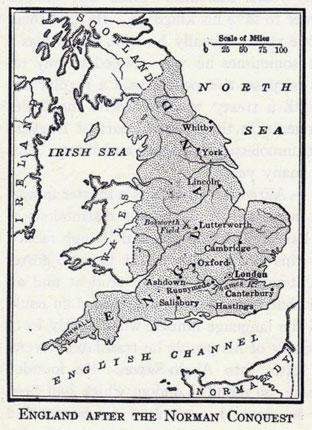
EARLY HISTORY OF JEWS IN ENGLAND
There may have been Jews in England from Roman times, but the first record of a Jewish settlement is 1070, just four years after the Battle of Hastings. William the Conqueror needed Jews for the Feudal System economy. Jews were not part of the regular Feudal System, and were not under any lord, but were declared to special subjects of the king.
The reason William needed Jews was that the church forbade money-lending for profit, but Jews could lend out money and charge interest. And the king could take whatever money he wished from the profits of the moneylenders in the form of taxes. So as the moneylenders' taxes went up, they had to keep raising their rates, until they were looked upon as extortionists.
Add to this an ever-growing number of literary anti-Semitic stories, such as the story of the Wandering Jew, and especially stories of blood libels and deicide, and anti-Semitic feelings ran rampant.
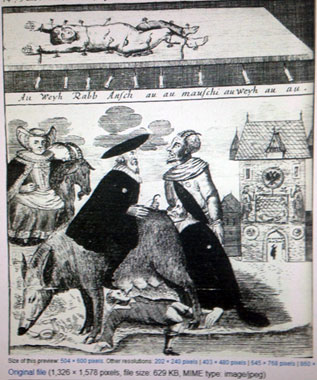
This illustration is from Italy, but similar stories were told throughout Europe, including England. A Christian boy vanished, and the Jews were blamed. We see young Simon of Trent laid out for butchering at the top, while below Jews fornicate with a goat and a pig while the devil watches.
Jews were expelled from England in 1290 by Edward I, and most of their property was seized by the crown. They were left with just enough to book passage out of England. Oliver Cromwell allowed Jews to return to England in 1655, where they were considered "nonconformists." They were not allowed to enter Parliament or go to college and were therefore denied the opportunities of many careers, including legal careers, but there were no other restrictions, unlike the Jews in rest of Europe. The first Jews to arrive were Sephardic Jews, who had been banished from Spain and Portugal, and who often were well-educated and wealthy from businesses in commerce.
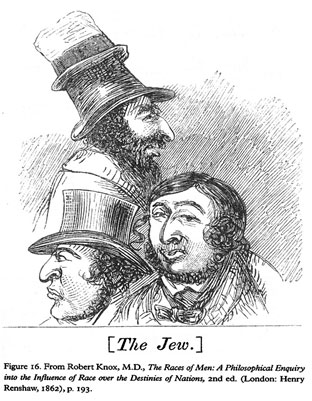
Following them were the poorer Ashkenazi Jews from Germany and Holland. Denied so many respectable trades, many started as peddlers and hawkers, and later dealing in furniture and clothing and then becoming tailors and shoe-makers.
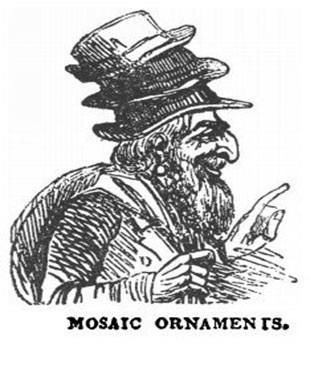
It was not unusual to see Jewish peddlers carrying bags of old clothes and wearing numerous hats as they traveled the streets of London.
A few Jews became well-known pugilists, who gained Christian fans.
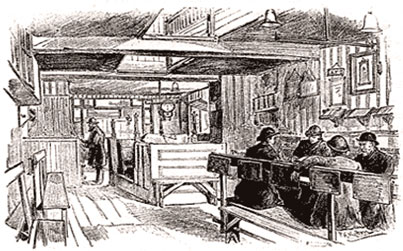
Three-quarters of the roughly 30,000 Jews living in 19th century England were living in London where they formed a strong community with a well-developed education system, charities and synagogues.
However, by law, Jews in England in 1830 could not receive a degree from a British university, practice law, enter Parliament, or open a shop within the City of London. Money-lending and selling second-hand clothes on the street were common ways for Jews to earn a living. Unfortunately there were also thieves and fences like Fagin.
Did Dickens know many Jews by the time he wrote Oliver Twist? We know from chapter 11 of Pickwick that there were large numbers of Jews in Portsmouth, Chatham and Rochester, three towns where he grew up, and of course there were also many Jews in London. Dickens describes many of them in Sketches by Boz.
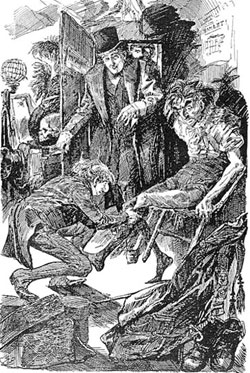
He often makes references to Jews renting fancy-costumes in letters regarding his theatrical ventures. In his fiction, a Jew rents fancy-dress to the Pickwickians when they attend Mrs Leo Hunter's party and as we see in this slide, a Jew rented Mr Wopsle his costume for Hamlet in Great Expectations. He also offered Mr Wopsle advice on how to stand on stage to the costume's best advantage.
JEWISH CANARDS
If Dickens was anti-Semitic when he wrote Oliver Twist, at least there is little evidence he believed any of the many canards that were told throughout history, many to the present day. But in the 19th century there were many people who believed that Jews killed Christian children for their blood to make matzoh, desecrated hosts or communion wafers, poisoned wells, had sexual relations with animals, and were collectively guilty for the death of Jesus. They were also lechers with a dangerous sexuality.

Some Victorians also believed there were "Secret Jews" - Jews in Christian disguises who one day would rise and take over England.
LITERARY JEWS
There was another type of Jew that Dickens would have been very familiar with: The literary stereotypical Jew.
And this has an interesting history. Edgar Rosenberg in From Shylock to Svengali, characterized 'the image of the Jew in English literature' as having been "a depressingly uniform and static phenomenon."
Remember I said the Jews were expelled from England in 1290? Yet for the next four hundred years, stereotypical Jews continuously appeared in English literature, drama and visual arts. Neither Chaucer, Marlowe nor Shakespeare would have known a single Jew.
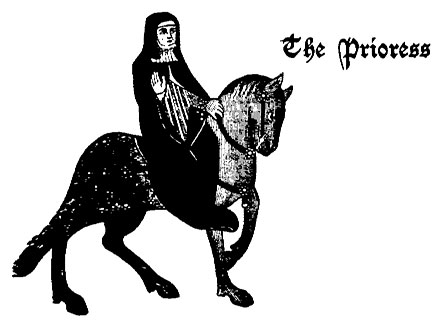
But in the end of the 14th century, Chaucer wrote "The Prioress' Tale," in which a Christian child is murdered by Jews as he walks through the Jewish quarter of a city in Asia.
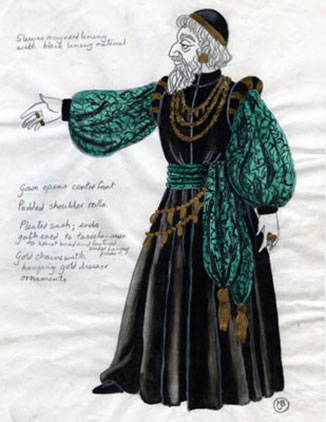
By 1590, Christopher Marlowe's Barabas, The Jew Of Malta, starts out sympathetically, but he quickly becomes a raging psychopath. Marlowe doesn't treat Christians and Muslims much better. Barabas loves being a villain.
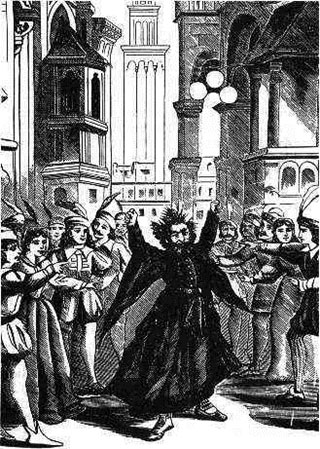
It is believed that Marlowe's Barabas was a major influence on Shakespeare's Shylock, who is the best known Jew in English literature. He is the archetypical Jewish moneylender. And remember Shakespeare never met a Jew. Shylock is an extremely complex character. He is a villain but he is funny. He has one of the most sympathetic, humanizing speeches in literature...I am a Jew. Hath not a Jew eyes? Hath not a Jew hands, organs, dimensions, senses, affections, passions?...If you prick us, do we not bleed? If you tickle us, do we not laugh? If you poison us, do we not die? And if you wrong us, shall we not revenge? If we are like you in the rest, we will resemble you in that. (Merchant of Venice, III.i)
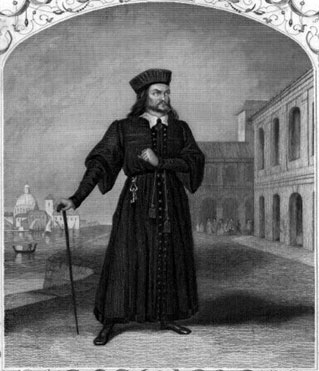
The great Shakespearean actor, William Macready, was one of Dickens's best friends, and I am sure Dickens saw Macready play Shylock many times. Here is Macready as Shylock...
Stereotypical Jews continue to appear through the centuries and the plays of the early 19th century were filled with stereotypical Jewish characters. And young Charles Dickens loved going to the theater.
OLIVER TWIST - 1838

Scholar Harry Stone points out to us several of Fagin's characteristics that were typical of a Stage Jew: "hooked nose, shuffling gait, and long gabardine coat and broadbrimmed hat." Stage Shylocks always wore red wigs. Furthermore Fagin is a dealer in second-hand clothes and trinkets, the Jewish occupation par excellence ...But he is strangely lacking in other traits of the literary Jew - he goes through no Jewish rituals, and unlike his Jewish confederate, Barney, has no lisp, dialect, or nasal intonation.
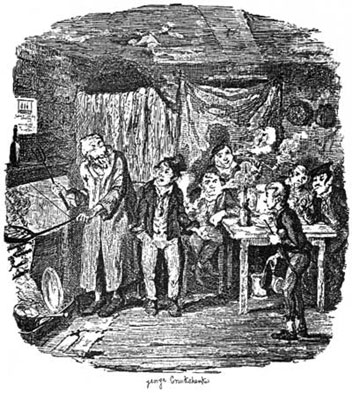
It is very interesting that Fagin doesn’t really do anything to indicate he is Jewish. When we first meet him, he is cooking sausages. We can be sure they weren't kosher sausages.
"In a frying-pan which was on the fire and which was secured to the mantelshelf by a string some sausages were cooking and standing over them with a toasting-fork in his hand was a very old shrivelled Jew whose villainous-looking and repulsive face was obscured by a quantity of matted red hair."
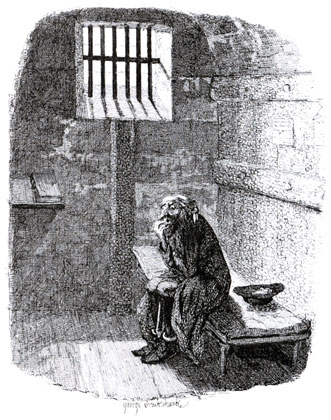
At the end of the novel, when Fagin is in the condemned cell, "Venerable men of his own persuasion had come to pray beside him, but he had driven them away with curses. They renewed their charitable efforts, and he beat them off." He refuses to associate with rabbis. There really is nothing Jewish about Fagin except he is called "The Jew."
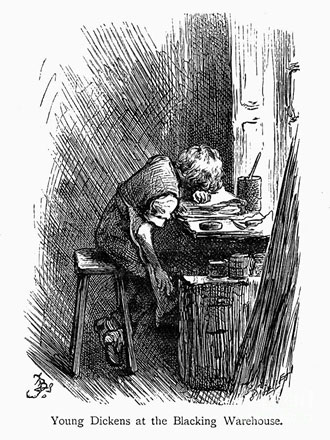
Fagin was named after a boy who befriended young Dickens when he was pasting labels on bottles in Warren's Blacking Factory. Fagin is an Irish name but it can also be an Ashkenazi name, and Bob Fagin may have been of Jewish ancestry.
Dickens describes Bob Fagin's gentle personality in part of his autobiographical fragment...
"Bob Fagin was very good to me on the occasion of a bad attack of my old disorder. I suffered such excruciating pain at that time, that they made me a temporary bed of straw in my old recess in the counting-house, and I rolled about on the floor, and Bob filled empty blacking-bottles with hot water, and applied relays of them to my side, half the day. I got better and quite easy towards evening; but Bob (who was much bigger and older than I) did not like the idea of my going home alone, and took me under his protection. I was too proud to let him know about the prison; and after making several efforts to get rid of him, to all of which Bob Fagin in his goodness was deaf, shook hands with him on the steps of a house near Southward-bridge on the Surreyside, making believe that I lived there. As a finishing piece of reality in case of his looking back, I knocked on the door, I recollect, and asked, when the woman opened it, if that was Mr Robert Fagin's house."
Naming the vile Fagin after such a kind-hearted friend is a strange pay-back.
Well, that's the name, but what about the character? As I mentioned, there were Jewish fences and the most notorious of these was the so-called Prince of Fences: Ikey Solomon.
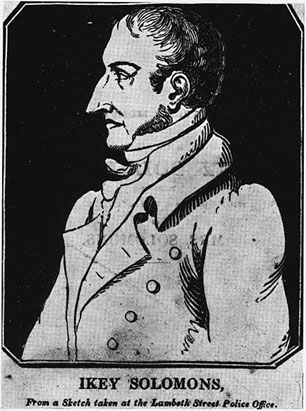
Ikey Solomon was a Jewish fence, a receiver of stolen goods, who operated a pawn shop in the area around Petticoat Lane. In 1810 he was caught stealing a purse from a gentleman outside of Westminster Hall. He was sentenced to be transported, but ended up in a prison hulk, like the ones in Great Expectations.
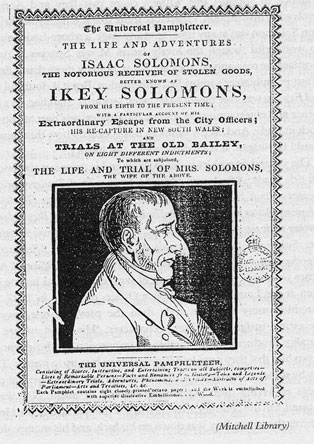
The information about his life is sketchy, but after adventures in London , New York and Tasmania, Ikey was put on trial at the Old Bailey in June, 1830 and sentenced to be transported to Van Diemen's Land, or as we know it, Tasmania. There are many similarities between Ikey's trial and Fagin's trial, and this leads some to believe he was the inspiration for Dickens's fence. Ikey was in jail when Oliver Twist came out. If Dickens wasn't influenced directly by the real Ikey, he may have been influenced by a fictional Ikey. A playwright named W.T. Moncrief had written a melodrama called Van Diemen's Land and one of the characters was a Jew named Barney Fence. The trial at Old Bailey gave Moncrief the idea to change Barney Fence's name to Ikey Solomons. The play remained popular throughout the 1830s and there is little doubt that Dickens must have seen it by the time he wrote Oliver Twist in 1838.
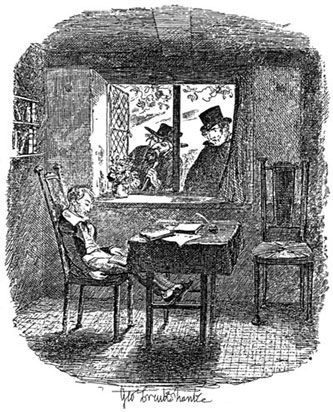
Next to Shylock, Fagin is the best known stereotypical Jew in the world.
In 1854 The Jewish Chronicle asked why "Jews alone should be excluded from the sympathizing heart of this great author and powerful friend of the oppressed."
Throughout his career Dickens frequently wrote about Jews. They are mentioned in most of his books. Sometimes he has an anti-Semitic bend, but sometimes he was very sympathetic to their plights.
Here are some examples in (mostly) chronological order.
SKETCHES BY BOZ - 1836
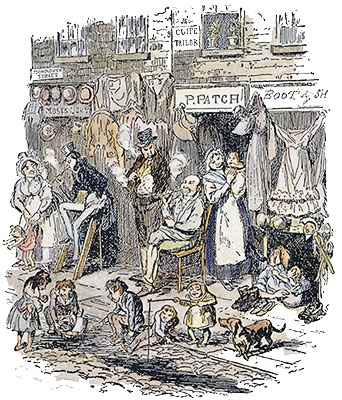
Monmouth Street, which is now part of Shaftesbury Avenue, had many old clothing stores, and Dickens wrote a sketch about it.
"We have always entertained a particular attachment towards Monmouth-street, as the only true and real emporium for second-hand wearing apparel. Monmouth-street is venerable from its antiquity, and respectable from its usefulness. Holywell-street we despise; the red-headed and red-whiskered Jews who forcibly haul you into their squalid houses, and thrust you into a suit of clothes, whether you will or not, we detest."
Dickens always worked closely with his illustrators, and this engraving by George Cruikshank is no doubt very accurate. We see two shops selling old clothes, one with the sign Moses Levy. About the same time, ...
PICKWICK PAPERS - 1836
In The Pickwick Papers, Solomon Lucas the Jew in the High Street of Eatanswill is described as having thousands of fancy-dresses.
THE OLD CURIOSITY SHOP - 1841
Quilp says of Grandfather: "He's richer than any Jew alive."
BARNABY RUDGE - 1841
In Barnaby Rudge, when Gashford thinks of Jews, he thinks of money and beards, and of course Lord Gordon converts to Judaism at the end of the novel, but that is history.
And we have this amusing paragraph as the Gordon Riots commence...
...most of the houses displayed a blue flag in token of their adherence to the popular side and even the Jews in Houndsditch Whitechapel and those quarters wrote upon their doors or windowshutters 'This House is a True Protestant.'
PICTURES FROM ITALY - 1846
Talking about Mantua, in Pictures from Italy, Dickens says, " ... there were some business-dealings going on and some profits realising for there were arcades full of Jews where those extraordinary people were sitting outside their shops contemplating their stores of stuffs and woollens and bright handkerchiefs and trinkets: and looking in all respects as wary and business-like as their brethren in Houndsditch London."
And he has this to say about Rome... "The little town of miserable houses walled and shut in by barred gates is the quarter where the Jews are locked up nightly when the clock strikes eight—a miserable place densely populated and reeking with bad odours but where the people are industrious and money-getting. In the day-time as you make your way along the narrow streets you see them all at work: upon the pavement oftener than in their dark and frouzy shops: furbishing old clothes and driving bargains."
DOMBEY AND SON - 1846
Oh Saturdays! Oh happy Saturdays when Florence always came at noon and never would in any weather stay away though Mrs Pipchin snarled and growled and worried her bitterly. Those Saturdays were Sabbaths for at least two little Christians among all the Jews and did the holy Sabbath work of strengthening and knitting up a brother's and a sister's love.
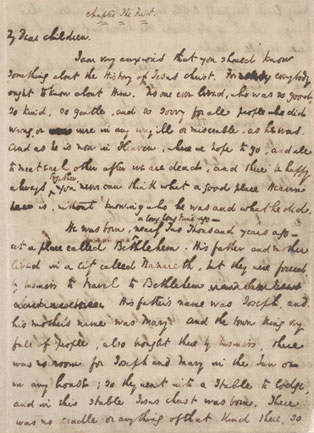
LIFE OF OUR LORD - 1849
A few years later, Dickens forgot that Jews celebrate the Sabbath on Saturday, and in The Life of Our Lord he said they celebrated the Sabbath on Sunday.
Jews don't come off well in The Life of Our Lord. Besides repeating at great length the deicide story from the New Testament, Dickens says that Jews were "very ignorant and passionate," and that "they were very proud, and believed that no people were good but themselves."
DAVID COPPERFIELD - 1850
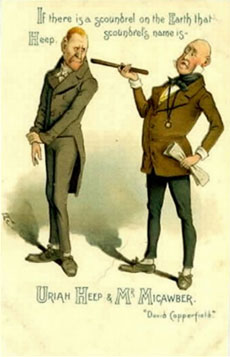
Mr Micawber says "Bills - a convenience to the mercantile world, for which I believe we are originally indebted to the Jews, who appear to me to have had a devilish deal too much to do with them ever since."
Earlier I had mentioned "Secret Jews" and some Dickensians think that Dickens might have had Secret Jews in mind when he created Uriah Heep. There are many clues to Uriah being a stereotypical Victorian Jew. He has a false humility (his being "umble") He has red hair, an old testament name, an unsavory appearance, a dangerous sexuality and an outlandish desire for wealth. He is out to destroy Mr Wickfield and he lusts for Agnes. Oh, and he is a blackmailer, an embezzler and a forger.
Uriah was probably based on a Christian, Thomas Powell, who "...ingratiated himself into the Dickens household" and dined several times at Devonshire Terrace. Powell embezzled £10,000 from his employer by forging documents. Later, he wrote pamphlets, attacking Dickens, calling particular attention to Dickens' background and social class.
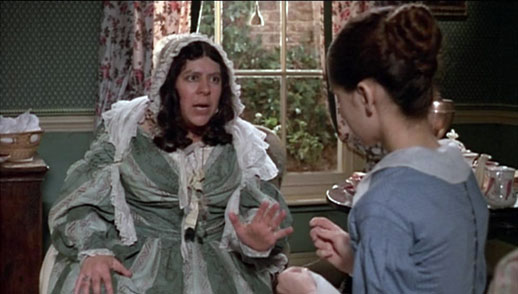
LITTLE DORRIT – 1855
Quoting what Dickens characters say about Jews in the novels as evidence of Dickens's feelings can be dodgy. For example, the following sentence by Flora Finching in Little Dorrit, may only reflect Flora's prejudices and not Dickens's.
"Really so sorry that I should happen to be late on this morning of all mornings because my intention and my wish was to be ready to meet you when you came in, and to say that any one that interested Arthur Clennam half so much must interest me, and that I gave you the heartiest welcome and was so glad instead of which they never called me and there I still am snoring, I dare say, if the truth was known and if you don't like either cold fowl or hot boiled ham, which many people don't, I dare say, besides Jews, and theirs are scruples of conscience, which we must all respect, though I must say, I wish they had them equally strong when they sell us false articles for real that certainly ain't worth the money - I shall be quite vexed"
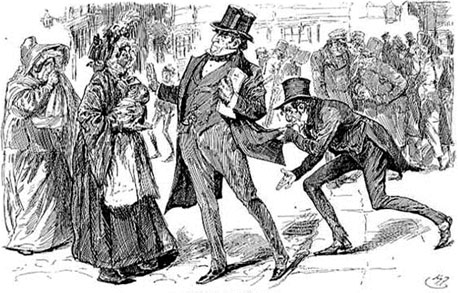
GREAT EXPECTATIONS - 1861
In Great Expectations, there are a number of clients waiting for Jaggers including, "a red-eyed little Jew...who was of a highly excitable temperament, performing a jig of anxiety, and accompanying himself, in a kind of frenzy, with the words, "Oh Jaggerth, Jaggerth! Give me Jaggerth!"
Jaggers arrives and the Jew raises "the skirts of Mr. Jaggers's coat to his lips several times."
Jaggers shows his prejudices and throws off "his supplicant off with supreme indifference, and leaves him dancing on the pavement as if it were red-hot."
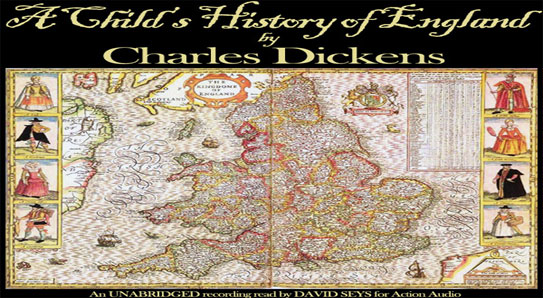
A CHILDS HISTORY OF ENGLAND – 1851
In 1851, Dickens wrote A Child's History of England, and here we really see his attitude changing. There are many references to the crown and the people mistreating the Jews.
"On the day of Richard I's coronation a dreadful murdering of the Jews took place which seems to have given great delight to numbers of savage persons calling themselves Christians."
And then later... (you need a definition here. "Clipping" means a small portion of a precious metal coins are shaved off. The shavings would be saved and eventually melted down. This was treated like counterfeiting and punishable by death.)
"To dismiss this sad subject of the Jews for the present I am sorry to add that in (Edward I's) reign they were most unmercifully pillaged. They were hanged in great numbers on accusations of having clipped the King’s coin—which all kinds of people had done. They were heavily taxed, they were disgracefully badged, they were on one day thirteen years after the coronation taken up with their wives and children and thrown into beastly prisons until they purchased their release by paying to the King twelve thousand pounds. Finally every kind of property belonging to them was seized by the King except so little as would defray the charge of their taking themselves away into foreign countries. Many years elapsed before the hope of gain induced any of their race to return to England where they had been treated so heartlessly and had suffered so much."
19th CENTURY PROGRESS
Let's go back to the 19th Century...
Even before Oliver Twist was published, other authors were writing about kind-hearted Jews. Walter Scott, who Dickens revered, had written Ivanhoe in 1820 with Issac of York and Rebecca winning the readers' sympathies. Rebecca is a paragon of virtue. Set during the reign of Richard I, the novel references many of the injustices to Jews during that time.
Catholics were emancipated in 1829, and Jews had hopes that they would soon follow. It took 30 years but there were milestones in those years. In 1837 Queen Victoria knighted Jewish financier and banker, Moses Montefiore. Montefiore also received a baronetcy in 1846 in recognition of his services to humanitarian causes on behalf of the Jewish people. The first Jewish Lord Mayor of London, Sir David Salomons, was elected in 1855.
Emancipation finally was achieved in 1858, and Jews had full rights as Englishmen. Lionel de Rothschild was able to become a member of the House of Commons when a law requiring members to take an oath "on the true faith of a Christian" was changed. Benjamin Disraeli, who was born a Jew, though baptized at age 12 into the Anglican Church, was already an MP, and on his way to a dazzling political career.

JAMES AND ELIZA DAVIS
In 1860 Dickens decided to sell his London home, Tavistock house. (that's the house to the right) A Jewish banker and his wife, James and Eliza Davis were interested in buying it. Dickens wrote to a friend, "If the Jew Money-Lender buys (I say 'if,' because of course I shall never believe in him until he has paid the money." But within a few days, the money was indeed paid, and Dickens wrote to another friend, "Tavistock House is cleared to-day, and possession delivered up to the new tenant. I must say that in all things the purchaser has behaved thoroughly well, and I cannot call to mind any occasion when I have had money-dealings with any one that have been so satisfactory, considerate, and trusting."
Dickens remained friendly with the Davises and three years later, Mrs Davis wrote to him and asked him if he would contribute to a fund to endow a convalescent home for Jewish poor. In the letter, she also commented, "It has been said that Charles Dickens the large hearted, whose works plead so eloquently and so nobly for the oppressed of his country … has encouraged a vile prejudice against the despised Hebrew." She went on to gently remind him that he was unjust to the Jewish people by having Fagin represent them in Oliver Twist. "Fagin I fear admits only of one interpretation; but while Charles Dickens lives, the author can justify himself or atone for a great wrong."
Dickens replied "I must take leave to say, that if there be any general feeling on the part of the intelligent Jewish people, that I have done them what you describe as 'a great wrong' they are a far less sensible, a far less just, and a far less good-tempered people than I have always supposed them to be. Fagin, in Oliver Twist, is a Jew, because it unfortunately was true of the time to which the story refers, that this class of criminal almost invariably was a Jew." (which was true) "But surely no sensible man or woman of your persuasion can fail to observe – firstly, that all the rest of the wicked dramatis personae are Christians" (This wasn't quite true, as Barney is also Jewish.) "and secondly, that he is called a 'Jew' not because of his religion, but because of his race. If I were to write a story, in which I described a Frenchman or a Spaniard as 'the Roman Catholic,' I should do a very indecent and unjustifiable thing; but I make mention of Fagin as a Jew, because he is one of the Jewish people, and because it conveys that kind of idea of him which I should give my readers of a Chinaman, by calling him Chinese. … I always speak well of them (the Jewish people) whether in public, or in private, and bear my testimony (as I ought to do) to their perfect good faith in such transactions as I have ever had with them."
Mrs Davis immediately responded and rebutted Dickens's reasoning and analogies. "It is a fact that the Jewish race and religion are inseparable, if a Jew embraces any other faith, he is no longer known as of the race, either to his own people or to the gentiles to whom he has joined himself....If, as you remark 'all must observe that the other Criminals were Christians' they are at least contrasted with characters of good Christians, this poor wretched Fagin stands alone 'The Jew' How grateful we are to Sir Walter Scott and to Mrs C.S. Hall for their delineations of some of our race, yet Issac of York was not all virtue!...I hazard the opinion that it would well repay an author of reputation to examine more closely into the manners and character of the British Jews and to represent them as they really are."
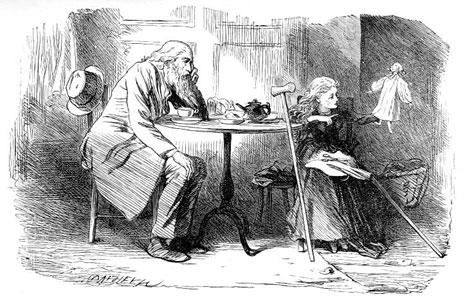
OUR MUTUAL FRIEND - 1864
Most Dickensian scholars agree that one of the reasons that Dickens created Riah in 1864's Our Mutual Friend was to counterbalance Fagin's wickedness with a pious Jew. "Riah" means "friend" in Hebrew.
In many ways, Riah is a failure as a Dickens character. Fagin dominates Oliver Twist. His actions drive the story. Riah isn't even a secondary character in Our Mutual Friend. He is more like a tertiary character. G.K Chesterton calls him a "needless and unconvincing character." And he is, by no means, a heroic figure. In fact, he is a bit effeminate. Jenny calls him Godmother, not Godfather.
But what Dickens intended Riah to be is very fascinating. Riah is a moneylender, and when a customer meets him, the customer assumes the worse...that the Jew will be a ruthless usurer. Of course, we know Riah's true character, and that he is a front for the truly wicked Fascination Fledgeby. But Dickens does use the two characters to good effect, as examples of tolerance and intolerance.
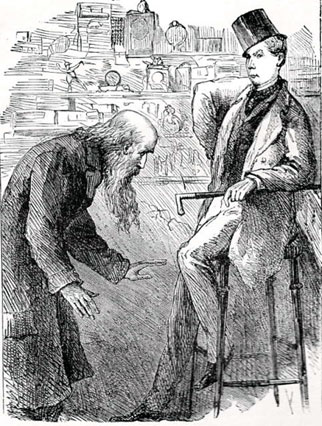
Fascination Fledgeby says, "Your people need speak the truth sometimes, for they lie enough."
Later...'Jews and generosity!' said Fledgeby. 'That's a good connexion! Bring out your vouchers and don't talk Jerusalem puh-lav-er'
Riah responds, "There is much untruth among all denominations of men."
Riah acts the role of an unfeeling usurer, but at the end of the novel, he throws off his yoke and says to Jenny,
I reflected that I was doing dishonour to my ancient faith and race. I reflected - clearly reflected for the first time - that in bending my neck to the yoke I was willing to wear, I bent the unwilling necks of the whole Jewish people. For it is not in Christian countries with the Jews as with other peoples. Men say 'This is a bad Greek but there are good Greeks. This is a bad Turk but there are good Turks.' Not so with the Jews. Men find the bad among us easily enough - among what peoples are the bad not easily found? - but they take the worst of us as samples of the best, they take the lowest of us as presentations of the highest, and they say ‘All Jews are alike.’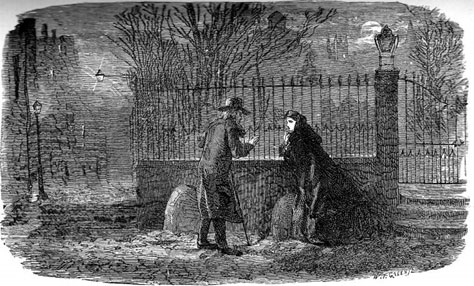
You will recall that Fagin threw off all attributes of Judaism. Riah follows the Jewish laws, goes to synagogue and is an active member of the Jewish community.
BIBLE
Mrs Davis greatly appreciated Dickens creating Riah, and wrote to him on November 13, 1864, thanking him for the "great compliment paid to myself and to my people." though she still pointed out that Riah was "something less than a realistic portrait."
Dickens responded that he received her comments with "great pleasure" confessed to some mistakes, and admitted that some of the "peculiarities of Riah's dress and manners are fixed together for the sake of picturesqueness." He closed with "I hope to be (as I have always been in my heart) the best of friends with the Jewish people."
I don't know if Dickens really believed what he wrote. Maybe he forgot the malicious comments of the past, but he really had changed.
Two definitions before I read the next extract. Mr Whelks was Dickens's generic name for the average lower-class workingman, and Whitechapel was a poor section of London with a large Jewish population.
In 1866, Dickens wrote in All the Year Round "Would it startle any one very much, if we were to express the opinion that Christian Mr Whelks in Whitechapel derives a good deal of his superiority as a well-regulated citizen from his association with those benighted and 'parlously' situated people, the Jews? Perhaps it would. Nevertheless, we make bold to express that opinion, and we hold by it very decidedly. In all that they do, whether in the pursuit of business or in the pursuit of pleasure, the Jews are an earnest, methodical, aspiring people...There is an innate feeling of pride in the race, which inspires even the humblest rag-gatherer with a desire to reach a higher sphere. They are sober and self-denying, prudent and careful...Their ceremonial law teaches what we polite Christians call etiquette to the commonest man of the tribe. They are a people who wash their hands and anoint their heads, and pay respect to times and seasons and observances. The character of Jews has too long been wronged by Christian communities. We take old-clothes men and thieves – there being none such among Christians, of course – as the types of an ancient, refined, and charitable people."

Mrs Davis was quite impressed with Dickens's transformation, and thanked him by sending him a beautiful Benisch Bible, the first time the English and Hebrew texts had ever been printed together. She wrote an inscription:
6th February 1867
Presented to
CHARLES DICKENS ESQ
in grateful and admiring recognition of his having exercised the noblest quality man can possess; that of atoning for an injury as soon as conscious of having inflicted it,
by a Jewess
Dickens thanked her on March 1, 1867, and finished the letter with "the terms in which you send me that mark of your remembrance are more gratifying to me than I can possibly express to you; for they assure me that there is nothing but good will between me and a People for whom I have a real regard and to whom I would not willfully have given an offense or done an injustice for any worldly consideration."
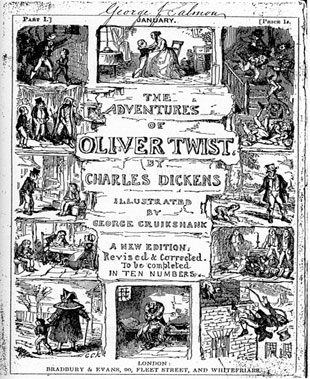
CHARLES DICKENS EDITION OF OLIVER TWIST
About the same time in 1867, The Charles Dickens Edition of Oliver Twist was being published. Much of the typesetting had been done when Dickens went in and edited out most of the remaining references to Fagin as "The Jew." He changed "The Jew" to either "Fagin" or "the old man" thus toning down much of the offensiveness, so that in the first 38 chapters, Fagin is called "the Jew" 257 times, but only a few times in the remaining 179 times he is referenced.
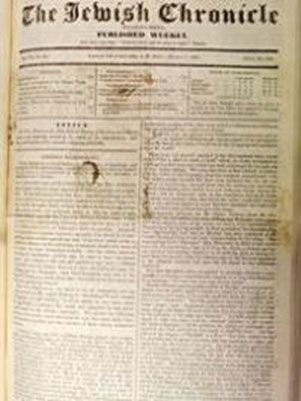
JEWISH CHRONICLE
When Dickens died suddenly on June 7th, 1870, The Jewish Chronicle, which you will recall in 1854 had questioned why his kind-heartedness did not extend to Jews, now said...
"We do not know all that we have lost. So long as journalism exists, so long as literature is valued, so long as humanity is estimated, so long, we think, will Charles Dickens be mourned. And surely, in the Jewish Journal some recognition of grateful memory is due to the generous spirit of the writer who, in the very early days of his life and his writings, he touched the Jewish character in a somewhat rough and undeserved severity, in the unreal character of Fagin, made ample amends in his later, wiser, more chastened days."
Thank you.
And I have to give many many thanks for extremely helpful suggestions and insights from three of my Dickensian friends,
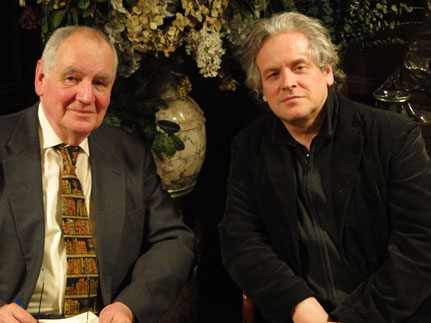
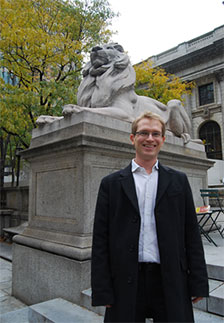
Michael Slater, Michael Patrick Hearn and Florian Schweizer.
Questions?
Thank you.
SOURCES
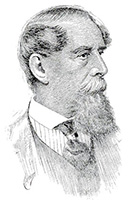
"Dickens and the Jews," Northwestern University, Harry Stone, March, 1959
"From Fagin to Riah: Jews and the Victorian Novel," Harry Stone, Midstream, Winter 1960
Charles Dickens: His Tragedy and Triumph, Edgar Johnson, 1952
From Shylock to Svengali, Jewish Stereotypes in English Fiction, Edgar Rosenberg, Stanford University Press, 1960
The Annotated Dickens, Edward Guiliano and Philip Collins, 1986
The Annotated Christmas Carol, Michael Patrick Hearn, 2004
"The Extraordinary Life of Charles Dickens," AKA "Charles Dickens Online," Bruce Crawford, 2004
The Letters of Charles Dickens, The Pilgrim Edition
The First Fagin, Documentary written and Directed by Alan Rosenthal and Helen Gaynor based on a book by Judith Sackville-O'Donnell, narrated by Miriam Margolyes
